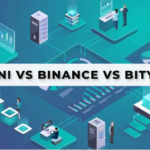
Stable tokens have become a linchpin in the ever-evolving world of decentralized finance (DeFi). They provide a means to attain price stability in the notoriously volatile cryptocurrency market. To ensure the security and stability of these stable tokens comes a crucial mechanism; over-collateralization.
In this article, we will explore the mechanics and strategic importance of over-collateralization, with a particular focus on Inter Stable Token (IST) as a case study.
Table of Contents
The mechanics of over-collateralization
Over-collateralization secures stable tokens by backing them with collateral exceeding their value. For instance, if a stable token is valued at $1, the collateral might be set at $1.5.
This surplus collateral acts as a buffer, which shields against market swings, reduces volatility, and boosts trust in the DeFi ecosystem. The strategy ensures a stable token maintains its peg to fiat or other stable assets as it’s crucial for stability amid market turbulence.
The strategic role of over-collateralization in DeFi
Over-collateralization is pivotal for DeFi, serving both as a technical necessity and a strategic advantage. It fortifies the ecosystem by enhancing security and stability for stable tokens against external shocks and internal risks.
1. Robust risk management
Over-collateralization acts as a key risk management tool, buffering DeFi against market downturns, ensuring system resilience, and minimizing susceptibility to cascading failures.
2. Confidence boost
The surplus collateral backing stable tokens instills market confidence by providing a secure foundation, which contributes to the stability and credibility of the entire DeFi ecosystem.
3. Efficiency in Liquidity and Finance
Over-collateralization enhances DeFi efficiency by utilizing surplus collateral to provide liquidity to exchanges or serve as collateral for diverse financial instruments.
Inter Protocol and IST: A Case Study in Over-Collateralization
Before examining the Inter Stable Token (IST), it’s crucial to understand the foundation and vision of Inter Protocol, the framework behind IST. Inter Protocol stands at the forefront of DeFi innovation, aimed at enhancing interoperability and stability across blockchains. It provides a solid foundation for the Inter Stable Token (IST), a testament to its commitment to security and efficiency in the volatile DeFi market. IST is a compelling case study exemplifying the implementation of over-collateralization in DeFi. IST’s versatility shines through its support for various collateral types and innovative approaches to achieve over-collateralization.
Over-collateralization and Technological Synergy
IST leverages the Parity Stability Module (PSM), allowing users to mint IST by exchanging other stable tokens such as USDC or USDT. Furthermore, users can utilize vaults to mint IST using assets like ATOM, stATOM, or other Cosmos IBC tokens.
The bedrock of IST’s security and stability lies in its robust over-collateralization strategy. By demanding users to deposit collateral assets exceeding the value of the intended IST, it creates a fail-safe against price fluctuations and market risks, ensuring full backing and peg maintenance.
Developed by Agoric, IST exemplifies DeFi innovation through its advanced technology. Agoric’s hardened JavaScript for smart contracts ensures a robust security framework, which promotes secure operations across diverse Cosmos blockchains. This technological foundation underpins IST’s resilience, offering users a dependable platform for their financial activities.
Governance and decentralization
Operating on the Agoric chain, IST incorporates a multi-faceted governance structure, involving BLD token holders and the Economic Committee (EC).
BLD token holders, who participate in staking, play a crucial role in chain-level votes and contribute to the governance decisions related to over-collateralization parameters.
Whereas, the EC, ensures informed operational decisions within the Inter Protocol as it serves a risk mitigation function. This dual-layered governance approach empowers the community to actively participate in adjusting collateral ratios and introducing new collateral types. This approach strengthens the ethos of decentralization and community-driven development within the IST ecosystem.
Economic implications
Beyond technology and governance, IST’s over-collateralization strategy carries significant economic implications for DeFi. This approach has the potential to stabilize lending markets, minimize systemic risk and improve capital efficiency. IST’s innovative stance contributes to the broader financial sustainability of decentralized finance by offering users value beyond the conventional.
Comparative Insights
IST and DAI share the over-collateralized stable token model, each backed by diverse tokens. However, their collateralization approaches differ significantly.
IST maintains a fixed collateral ratio of 250%, meaning users always have to deposit 2.5 times the value of IST they want to mint. This simplifies the user experience and reduces liquidation risks.
In contrast, DAI employs a variable collateral ratio based on risk parameters of each collateral type. This requires users to monitor changes in the collateral ratio and adjust positions accordingly. DAI also doesn’t have a mechanism that is similar to the PSM on inter protocol.
Notably, IST’s compatibility with Cosmos IBC protocol allows seamless cross-chain communication. On the other hand, DAI, native to the Ethereum Blockchain, faces limitations in interoperability with other blockchains.
Addressing challenges and criticisms
While over-collateralization strengthens stability, reliance on collateral value and market dynamics poses challenges. Ensuring the resilience of collateral assets against market drops is critical. IST addresses these concerns by actively managing collateral types and ratios, aiming to mitigate risks and enhance user accessibility and experience.
Conclusion
The role of over-collateralization in stable tokens is crucial for DeFi’s growth, balancing stability with innovation. As the DeFi sector evolves, the practices surrounding over-collateralization will likely continue to shape the landscape, striking a delicate balance between stability and innovation. IST’s approach, supported by Inter Protocol’s robust framework, exemplifies how over-collateralization can be effectively leveraged to foster security, efficiency, and user trust in the DeFi ecosystem.










